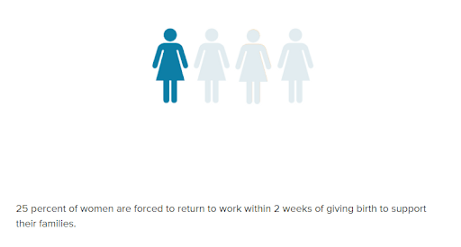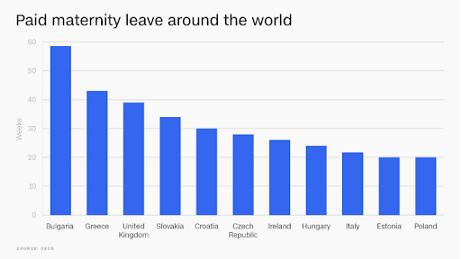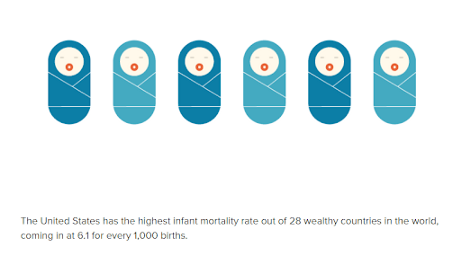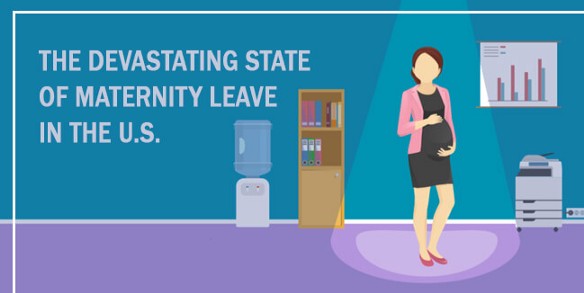It takes nearly 40 weeks for a woman to give birth to a full-term baby. Although pregnant women are going through a multitude of symptoms such as nausea and fatigue, yet they’re expected to keep working(instead of being given maternity leave) and carry on with their everyday life.
After giving birth, women go through an intense period that requires all sorts of care for them and their babies. The postpartum period can last up to six months, during which their bodies experience many changes, including tackling breastfeeding, sleep deprivation, and hormonal mood swings.
Yet, 25% of women in the U.S. have to go back to work in just two weeks postpartum to make ends meet.
This defeating maternity leave statistic brings us to the question we’ve all been asking: Why is America the only developed nation without good maternity leave?
Let’s try to examine the issue and what can be done to help women in our country.
Disturbing Maternity Leave Facts in the United States
Upon reading the following statistics, I think everyone will agree that these facts are quite depressing and concerning.
Here’s a sneak-peak into the darker side of the United States:
- The United States is not among the 178 countries that guarantee paid maternity leave.
- The United States is the only wealthy and developed country not to offer paid maternity leave on a federal level. Each state votes its own paid maternity law. Only four states offer paid family leave laws, including California, Rhode Island, New Jersey, New York, and the District of Columbia.
- For the majority of American women, motherhood and career are in close conflict. Why? Because their careers suffer after having children! New mothers have difficulties advancing financially and reaching high-level leadership positions.
- The Family Medical Leave Act (FMLA) provides 12 weeks of unpaid job leave, at the federal level. Nearly 40% of women don’t qualify even for the limited 12 weeks of unpaid leave. What’s more, it’s most often used for medical leave.
- The United States and Papua New Guinea are the only two countries in the world that don’t guarantee paid maternity leave. The U.S. ranks second in the world for the highest GDP, while Papua ranks 139th. Although the U.S. is a much more developed country than Papua, women in these countries face the same fears of choosing between motherhood and a career.
- 88% of American women don’t get paid for a single day after giving birth.
- Only 12% of women who work in the private sector have access to paid maternity leave.
- 40% of American employers choose not to offer any paid maternity leave.
How is it possible that a country that prides itself on family traditions be so behind with family-friendly policies? A country that ranks 2nd in the world for the highest GDP can’t guarantee paid maternity leave to mothers when they’re most vulnerable?
Additional Reading: Top Negotiation Tips for Women by Recruiters to End the Wage Gap

Source: Healthline
The U.S. vs. Other Developed Countries
In some countries of the world, employers pay a new mother at least half of her previous salary during the time off. In other, there’s the possibility to take paid paternity leave for several months.
Here is a short overview of paid maternity leave in other countries around the world:
Country: Australia
Maternity leave: 18 weeks
Average pay rate: 42% of their former salary
Country: Austria
Maternity leave: 16 weeks
Average pay rate: 100% of their former salary
Country: Greece
Maternity leave: 43 weeks
Average pay rate: 54.2% of their former salary
Country: Bulgaria
Maternity leave: 58.6 weeks
Average pay rate: 78.4% of their former salary
Country: Estonia
Maternity leave: 20 weeks
Average pay rate: 100% of their former salary
Country: The United Kingdon
Maternity leave: 39 weeks
Average pay rate: 30.9% of their former salary
Country: Netherlands
Maternity leave: 16 weeks
Average pay rate: 100% of their former salary
Country: United States
Maternity leave: 0 weeks
Average pay rate: 0%

Additional Reading: The Most Desirable Types of Employee Benefits Your Team Will Love
Maternity Leave Is Good for Individuals, Businesses, and the Economy
Research shows that paid maternity leave is good for individuals, businesses, and the economy. Paid leave increases the chances that the worker will return to work after childbirth. It can also lead to:
- Improved employee morale
- Increased workplace productivity
- Reduced costs
- Higher employee retention
Longer paid maternity leaves can lead to vast economic benefits such as reduced government spending on public assistance and an increased labor force participation. This can lead to increased consumer spending and a more extensive tax base.
Women make up a large portion of the United States’ GDP. Meaning, if they don’t return to work, the U.S. would have difficulties maintaining its economic status.
Beyond economic growth, paid maternity leave can also do wonders for the well-being of the newborn baby. Out of 28 developed countries in the world, the United States has the highest infant mortality rate or 6.1 deaths for every 1,000 births. However, infant mortality rates drop with improved paid maternity leave policies.
Mothers who get to spend more time with their babies form better bonds with them and nurture healthier children. This means fewer sick babies, fewer care expenses, as well as fewer requests for time off down the road.
Additional Reading: Generational Diversity at the Workplace: Benefits, Challenges, and Tips for Success

Source: Healthline
Is There Hope?
There are a few good reasons to believe that the U.S. is taking the right steps into offering better-paid maternity leave to its citizens.
Leaders from the Democratic and Republican parties have recently expressed their support for paid family leave programs at the federal level. This year in February, Senator Kirsten Gillibrand of New York and Representative Rosa DeLauro of Connecticut, reintroduced the Family Act. According to this act, Americans will receive up to 12 weeks of paid leave at a 66% pay rate. The act is an extension of existing law, the Family and Medical Leave Act of 1993, which offers only unpaid leave.
What’s more, seven states and Washington, D.C., will offer or will soon offer paid leave through low-cost, social insurance-style plans.
Many companies in the U.S. are also beginning to introduce paid maternity leave to its employees. Companies are modernizing their benefits package to better align with the needs of an evolving workforce. They’ve come to realize that attracting the best talent means offering an attractive set of workplace perks.
Microsoft, for example, offers a five-month paid leave to all new mothers, and three months for fathers, adoptive parents, and foster parents. Deloitte offers twenty-two weeks paid maternity leave for mothers and sixteen weeks for dads.
And finally, let’s not forget the public eye and their support for a federal leave program. Many advocacy groups are working hard to improve maternity leave programs in the country. From writing letters to federal and state legislators to testifying at courts, these activists are bringing the country one step closer to family-friendly policies.
Final Word
It’s my most hopeful belief that it’s only a matter of time until America starts offering a paid maternity leave for all working women as paid leave is bound to be available to many more workers who want to enjoy their parenthood stress-free.
However, that will only happen sooner if we all speak up and make it happen. Every one of us should get involved by pressuring the government and employers into offering more family-friendly policies to people who want to expand their families in the coming years. If we all raise our voices, we’ll create a better future for ourselves, our colleagues, our partner, and our children.









